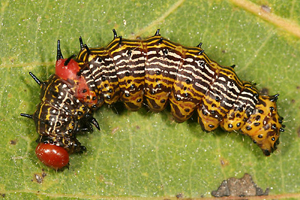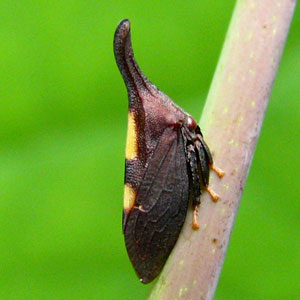Leaf Feeders
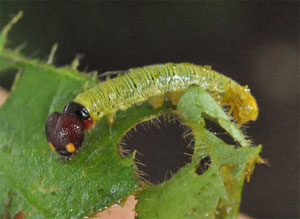
Lee Townsend, University of Kentucky Entomology
Silverspotted skipper is a distinctive caterpillar that feeds on black locust. It has a dark reddish brown head with a large yellow eyespot on each side. The body is yellow with several thin dark ring-like markings around each segment.These caterpillars use silk to hold several leaves together to form shelters that protect them from predators. There are two to three generations each year.
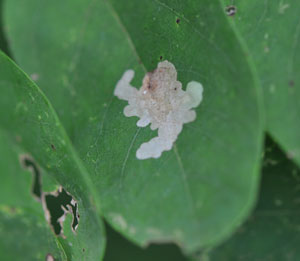
Lee Townsend, University of Kentucky Entomology
Locust leaf miners are flat larvae that produce blotchy blister-like areas as they feed inside leaf tissue. Much of the locust foliage may turn brown by mid-summer if this insect is very abundant. The damage often looks more serious than it is but may combine with other stresses to slow growth and even cause some tree mortality. The flat, yellow-orange and black adults chew a series of small round holes in leaves in the spring. Eggs are laid on the foliage and the small legless larvae enter leaves and produce blister-like mines that expand as they feed.
There are two generations each year. Healthy, vigorous trees are more tolerant of borer attack than are stressed trees.
At its largest, the Redhumped caterpillar is 1-1.5 inches long. The head and first abdominal segment are red, the rest of the body is yellow with black and white stripes. Black tubercles extend from the back. These caterpillars initially feed as a group on a single leaf, skeletonizing it, and use a collective warning display to ward off predators. As they grow, they will spread out as individuals and consume entire leaves. Mature larvae overwinter in the soil and pupate in the spring. Adults fly from June till July and caterpillars feed July to September.
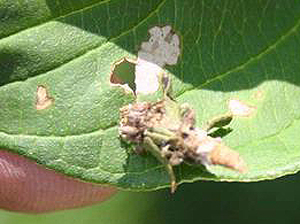
William Fountain, University of Kentucky, Bugwood.org
Bagworms are caterpillars that live in distinctive spindle-shaped silk bags covered with small bits of leaves from the host plant. Large populations of bagworms can strip plants of their foliage and eventually cause them to die. Infestations often go unnoticed because people mistake the protective bags for pine cones or other plant structures. For more information, see Entfact 440.
Sap Feeders
Treehoppers are small, active insects that live on the underside of the leaves. They use sucking mouthparts to feed on plant sap. They are very similar to leafhoppers, but have exaggerated pronotums that may resemble humps, thorns, or spikes. Usually large numbers are present by the time the injury is obvious. Heavily damaged leaves may drop early but this insect usually does not cause serious problems.
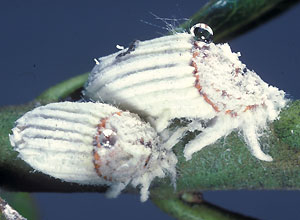
Sturgis McKeever, Georgia Southern University, Bugwood.org
Cottony cushion scale is an invasive scale species that can be found feeding on the sap of numerous species of plants. Adult females are orange-brown but coated with white wax and will have a long, fluted egg sac attached to the body. This can contain up to 1,000 eggs. After hatching, the nymphs (which are red with dark antennae and legs) will seek a suitable space for feeding. Nymphal feeding on leaves can cause extensive damage and honeydew/black sooty mold will accumulate as the population builds.
Borers
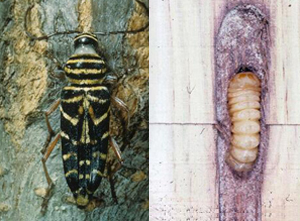
Jim Baker, North Carolina State University, Bugwood.org (adult);
Lacy L. Hyche, Auburn University, Bugwood.org (larva)
Locust borers are serious pests of young and old trees; those growing on poor sites are especially susceptible to infestation. Trees weakened by borer tunneling are especially prone to wind damage. Trees attacked for several years will grow slowly and have a bushy appearance.
Eggs are laid in bark cracks from late summer into October. Small wet spots on the bark during early spring may be a sign that borers are active. Fine sawdust may accumulate at the base of infested trees later in the year. This borer does not attack honeylocust.
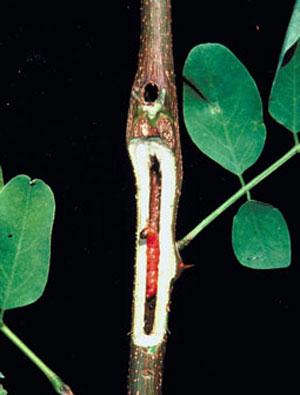
James Solomon, USDA Forest Service, Bugwood.org
Locust twig borers are red to yellow caterpillars that tunnel in and cause long, irregular swellings in new growth of twigs. Often sawdust is present and the swollen area bends and cracks. Infestations stunt the growth of young trees and may kill seedlings.
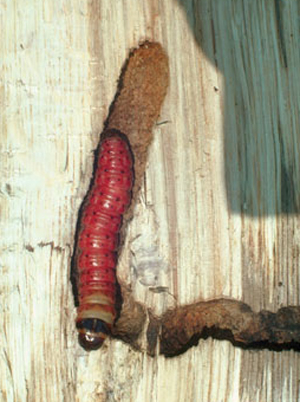
James Solomon, USDA Forest Service, Bugwood.org
Carpenterworms are reddish pink caterpillars that tunnel into the bark and wood of oaks, especially red oaks and a number of other hardwoods. Their damage causes unsightly scars on ornamental trees and degrades rough sawn lumber. Eggs are laid in bark crevices or under vines and lichens. Small larvae feed in the phloem and cambium but soon chew into the sapwood. Fine frass mixed with sap is ejected from the entrance hole in the bark and builds up at the base of the tree as larvae hollow out galleries beneath the bark. Infested trees usually are not killed but long term attacks may weaken trees structurally.
